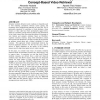Free Online Productivity Tools
i2Speak
i2Symbol
i2OCR
iTex2Img
iWeb2Print
iWeb2Shot
i2Type
iPdf2Split
iPdf2Merge
i2Bopomofo
i2Arabic
i2Style
i2Image
i2PDF
iLatex2Rtf
Sci2ools
126
click to vote
CIVR
2008
Springer
2008
Springer
Web-based information content and its application to concept-based video retrieval
Semantic similarity between words or phrases is frequently used to find matching correlations between search queries and documents when straightforward matching of terms fails. This is particularly important for searching in visual databases, where pictures or video clips have been automatically tagged with a small set of semantic concepts based on analysis and classification of the visual content. Here, the textual description of documents is very limited, and semantic similarity based on WordNet's cognitive synonym structure, along with information content derived from term frequencies, can help to bridge the gap between an arbitrary textual query and a limited vocabulary of visual concepts. This approach, termed concept-based retrieval, has received significant attention over the last few years, and its success is highly dependent on the quality of the similarity measure used to map textual query terms to visual concepts. In this paper, we consider some issues of semantic simi...
Related Content
| Added | 18 Oct 2010 |
| Updated | 18 Oct 2010 |
| Type | Conference |
| Year | 2008 |
| Where | CIVR |
| Authors | Alexander Haubold, Apostol Natsev |
Comments (0)

